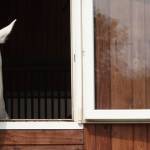Tips for Managing Horses on Stall Rest

A horse may face stall rest for a number of reasons, such as recuperation from an injury, illness, or surgery. Owners often become worried about how best to manage the situation. Whether or not grain needs to be reduced or changed, enrichment opportunities, and general maintenance of equine safety and sanity are all things to consider.
When confronted with long-term stalling, where should horse owners begin?
Start by setting up a clean, comfortable stall that is free of potential hazards, such as broken boards, holes, and sharp objects. If possible, a stall with a window will provide the horse with fresh air and sunshine. A window will also help ensure ventilation and airflow. Consider the size of the stall and how much movement is allowed, based on the reason for the horse’s confinement. In the summertime, a commercial-grade fan will help keep flies and mosquitoes at bay as well as provide a cooling breeze.
Horses are herd animals that typically do not like to be alone. Having a buddy within view may help relax a stall-bound horse, especially when other stablemates are turned out. Companions can be rotated, and may include other horses, goats, or donkeys. Human interaction that includes grooming may help, too. If the veterinarian permits hand-walking, this is a great way to help the horse loosen tight muscles, prevent edema, and alleviate boredom. In some cases, hand-walking may be part of the recovery process. The veterinarian will make recommendations for how much exercise the convalescing horse should have.
Providing enrichment helps stave off monotony. Stall toys, such as thick rubber balls made for horses, traffic cones, or other soft items, are inexpensive and help pass the time. Use your best judgment to ensure toys won’t aggravate an injury or a healing wound. Avoid toys that include sugar-laden treats, which may make a confined horse restless or add unnecessary calories.
When it comes to diet, the body requires nutrients and energy to heal. The ration needed to maintain a performance horse, however, is often too much for a horse confined to a stall. Consider seeking the advice of a nutrition consultant about how to best modify the ration of a stall-bound horse, though some basic management practices still apply.
Confined horses need forage. Horses restricted to stalls have an increased risk of colic and gastric ulcers, but ensuring adequate intake of water and good-quality forage are ways to help minimize the risk. When feeding forage, consider using haynets with small holes to extend the time it takes for a horse to consume hay, increase chew time, boost saliva production, and encourage the horse to work a little harder for each bite, helping to keep it occupied.
Certain nutritional supplements support recovery. DuraPlex promotes healthy bone metabolism and tissue structure during convalescence, and RiteTrac supports the health of the entire digestive tract. Australian horse owners can look for these digestive health products.
Finally, specialized rehabilitation facilities are an option for horses needing intense care, or for owners who need help meeting the horse’s needs during recovery, such as frequent hand-walking. Each horse is different, and each will handle confinement in its own way. Work with your veterinarian and nutritionist to devise a tailored plan for a healthy recovery.








